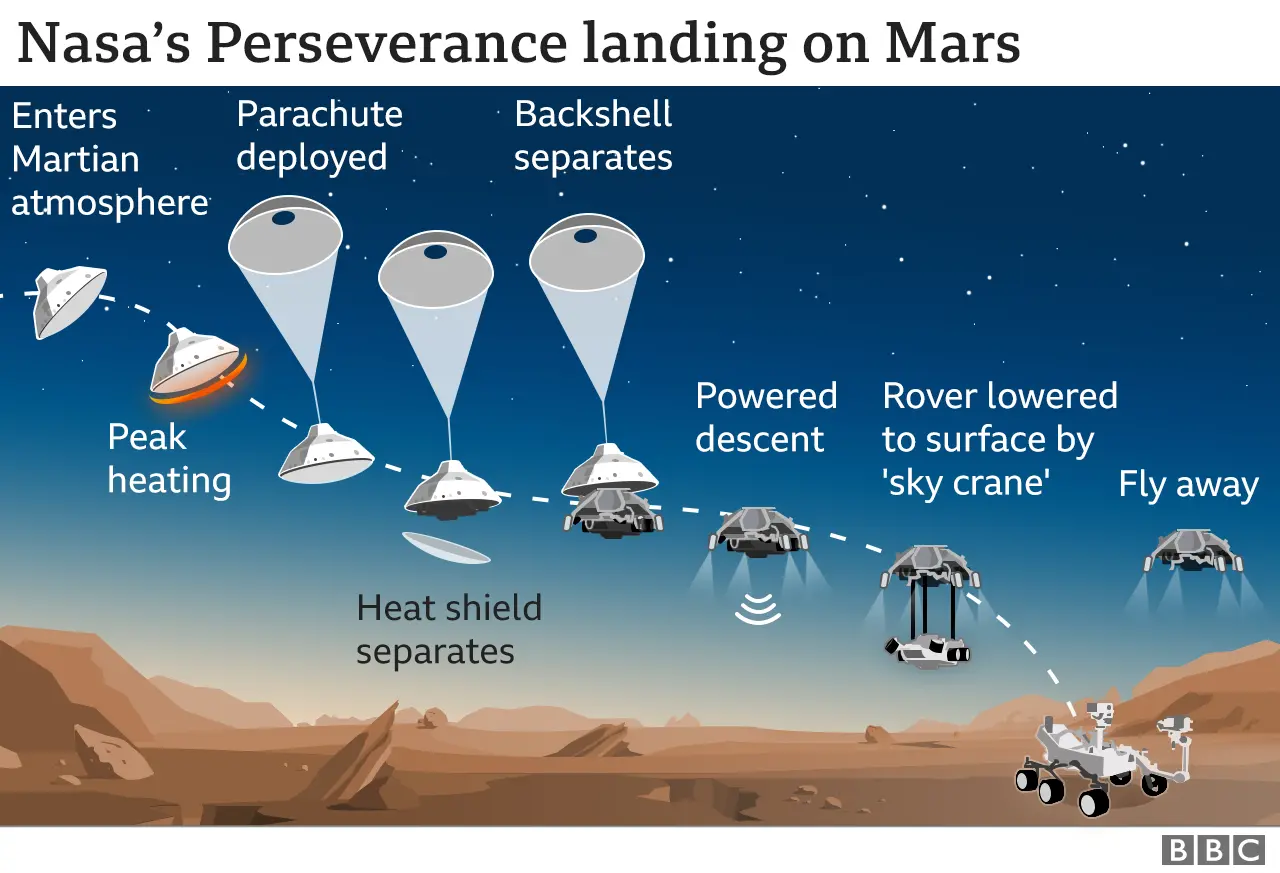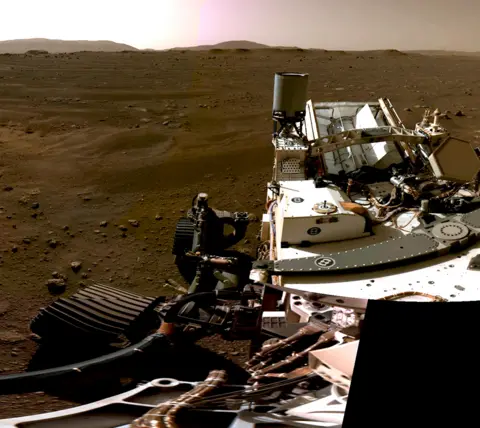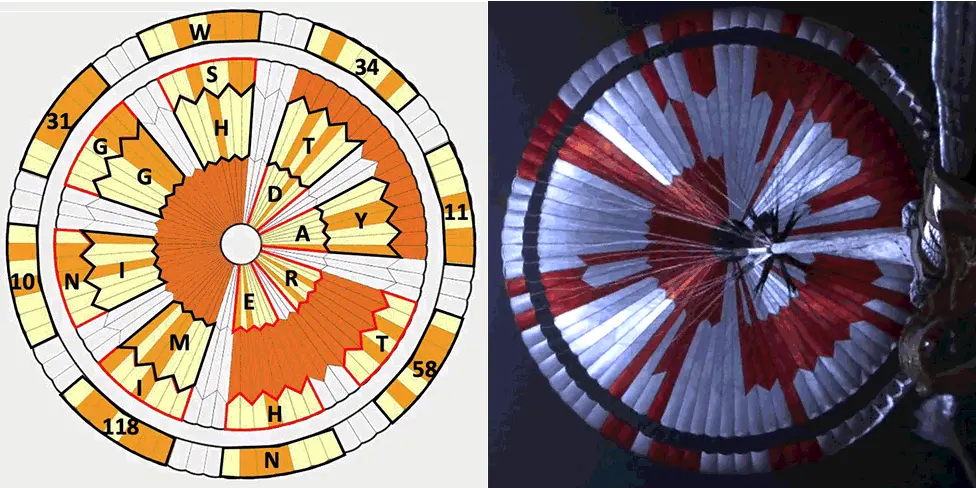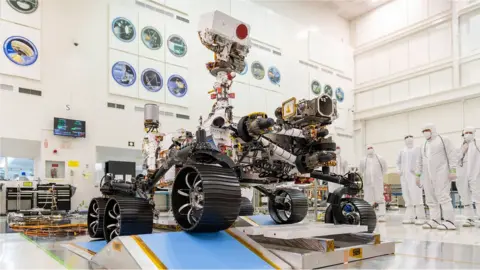Video shows Perseverance rover's dramatic Mars landing
Nasa has released stunning videos of its Perseverance rover landing on Mars.
The movies cover the final minutes of last week's hair-raising descent, up to the point where the robot's wheels make contact with the ground.
The sequences show a whirl of dust and grit being kicked up as the vehicle is lowered by its rocket backpack to the floor of Jezero Crater.
Perseverance was sent to Mars festooned with cameras, seven of which were dedicated to recording the landing.
Their imagery represents vital feedback for engineers as they look to improve still further the technologies used to put probes on the surface of the Red planet.

Mike Watkins, the director of the Jet Propulsion Laboratory (JPL) in California, which is home to Nasa's Mars mission control, said the spectacular videos were an example of the agency at its best.
"We have taken everyone along with us on our journeys across the Solar System, through the rings of Saturn, looking back at the 'Pale Blue Dot' and incredible panoramas on the surface of Mars. This is the first time we've been able to actually capture an event like the landing of a spacecraft on Mars," he told reporters.
"We will learn something by looking at the performance of the vehicle in these videos. But a lot of it is also to bring you along on our journey."
All the cameras employed in the descent and landing were off-the-shelf, ruggedised sports cameras, with next-to-no modifications.
 NASA/JPL-CALTECH
NASA/JPL-CALTECHThe cameras were positioned to capture key hardware events - from the release of the supersonic parachute, through the jettisoning of the entry capsule's heatshield and flight of the backpack, or "sky crane", all the way through to touchdown and the backpack's disposal.
This corresponded to roughly the final four minutes of the rover's seven-minute descent to the surface.
"We collected a little over 30 gigabytes of information, and over 23,000 images of the vehicle descending down to the surface of Mars," explained Dave Gruel, who led the camera effort at JPL.
Allow X content?
One of the three cameras looking up at the parachutes failed, but the other six cameras worked flawlessly. Nasa had hoped also to record the sound of the descent with a microphone, but unfortunately this didn't succeed.
However, the team has managed to get a mic operating on the ground so there is the possibility of hearing Perseverance go about its exploration duties in the coming weeks. Already, the muffled sound of the wind in Jezero Crater has been played back.
Videos have been made at Mars before, but these were low frame-rate affairs - more what you might call "stop motion" action. The Perseverance offering on the other hand is simply jaw-dropping in its clarity and detail.
"It gives me goose bumps every time I see it - just amazing," said Gruel.
 NASA/JPL-CALTECH
NASA/JPL-CALTECHEncoded in the parachute is a 10 bit pattern that spells out the coordinates (34°11'58"N 118°10'31"W) of Nasa's Jet Propulsion Lab and its moto: "Dare mighty things"

Engineers at JPL continue the work of commissioning the robot.
At the weekend, Perseverance's navigation mast, which had been stowed flat since leaving Earth last year, was raised into the vertical.
This allowed the main science cameras at the mast's top, the Mastcam-Z system, to begin building a panorama of the surrounding terrain in Jezero and of the deck of the rover itself. The latter mosaic is wanted to look for any damage that might have been inflicted by flying stones at the time of landing.
Controllers will this week perform the critical task of transitioning Perseverance away from the software that got it safely down to the surface of Mars to one that enables the robot to rove and use equipment such as its robotic arm.
This is likely to take four Martian days, or Sols (a Martian day lasts 24 hours and 39 minutes). We might see a wheel wiggle and the first test drive of a few metres come the weekend.
 NASA/JPL-Caltech/University of Arizona
NASA/JPL-Caltech/University of ArizonaThere's huge interest in the mini-helicopter that travelled with the rover. The 2kg device will perform the first powered flight on another world.
But first Perseverance needs to find the right place to put this aircraft down to conduct its experiments. Mission planners said on Friday it would be a few weeks yet before the robot reached this chosen location, meaning it's probably going to be April before Ingenuity, as the little chopper is known, takes to the skies.
Allow Google YouTube content?
A 360-degree view of Jezero Crater made by the Perseverance rover

A Nasa satellite, the Mars Reconnaissance Orbiter, has already identified and photographed the discarded hardware from landing.
"The descent stage (backpack/sky crane) is about 700m away from where Perseverance is on the surface. The parachute is about 1.2km and the heatshield about 1.5km. And so it's very exciting that we can see all these different components," said Jessica Samuels, the Perseverance surface mission manager.
The robot's landing spot is in a 1.2km by 1.2km quadrangle that the science team has informally called Canyon de Chelly after the National Monument in the US State of Arizona.
 NASA/JPL-CALTECH
NASA/JPL-CALTECHPerseverance is sitting on a flat piece of ground at the boundary of two geologic units - a smooth unit under the wheels of the vehicle that contains what are likely to be dark volcanic rocks; and a rougher unit that has rocks with a lot of the mineral olivine in them.
About 2km to the northwest is what looks from satellite images to be the remains of a delta that formed when Jezero was filled by a giant lake billions of years ago.
Deltas are created when rivers enter a wider body of water and dump silt and sand. It's in these sediments that Perseverance will look for signs of past microbial activity.
 NASA/JPL-Caltech
NASA/JPL-Caltech